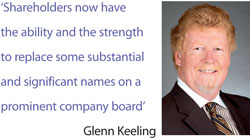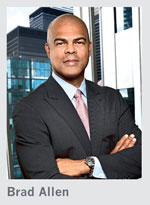Activist investor William Ackman forced major board restructuring in record time
It’s very rare when everyone in the marketplace agrees about something at the same time, but in the case of Pershing Square Capital Management’s ground-breaking proxy battle with Canadian Pacific Railway (CP), no one can deny that a major shift is under way in the Canadian market.
William Ackman is the architect of the boardroom coup that installed a slate of seven board members onto Canada’s second-largest railroad in one major action.
Canada had not seen anything like this happen to as large a company as CP before, and Ackman crowed loudly about his accomplishment in a Globe and Mail article in May.
‘In every significant boardroom they are talking about the Canadian Pacific proxy contest and … what is the right thing to do for a board,’ Ackman is quoted as saying.
‘Directors are sitting up more straight and reading board materials more carefully and questioning the CEO more intently. That is a very, very good thing.’
Ackman is right, and while some may not admit this, these developments have grabbed everyone’s attention.
Wary directors
Directors in Canada in particular are more aware now that investors are watching them more closely.
In the back of their minds, they are likely wondering how this may affect them in the future.
Staring them in the face is the reality that Ackman purchased just over 14 percent of CP’s shares in October last year, and by May 17, he had CP chairman John Cleghorn, CEO Fred Green and four other board members announcing that they would resign their positions and not stand for re-election to the board just prior to the company’s annual shareholder meeting.
In a matter of months, Ackman, with the help of a team of advisers, had convinced an overwhelming number of investors to back his efforts to gain board representation and replace the CEO at one of Canada’s iconic businesses.
For a company of CP’s size and stature, this was a first – and a wake-up call.
‘A change of that magnitude only reinforces the fact that shareholders have the ability, the strength and the wherewithal to actually replace some substantial and significant names on a very prominent company board – and it’s not going to be taken lightly,’ says Glenn Keeling, partner at Phoenix Advisory Partners. ‘We are expecting a great deal more of this type of behavior,’ Keeling adds. ‘It’s a combination of poor stock performance and wrong-side governance – not enough independence and not enough oversight. If you think this thing is a flash in the pan, it’s not.’
‘We are expecting a great deal more of this type of behavior,’ Keeling adds. ‘It’s a combination of poor stock performance and wrong-side governance – not enough independence and not enough oversight. If you think this thing is a flash in the pan, it’s not.’
‘The fact that this occurred in such an overwhelming way demonstrates both to issuers and to investors that it could happen to any company,’ says Riyaz Lalani, chief operating officer of Kingsdale Shareholder Services, which was one of Pershing Square’s primary strategic advisers during the proxy battle.
‘Proxy fights used to be the providence of small and mid-cap companies and every year there are dozens of them in Canada, but I don’t think any of these large, sophisticated boards thought that it was possible – so this is a new reality for them.’
Words to the wise
To adjust to the ‘new reality’ of dealing with proxy contests, Canadian publicly traded companies should be mindful of the following factors.
- Engage shareholders before activists show up. Companies must make better efforts to understand their shareholders’ concerns before activists show up and use those concerns against management.
‘It is important that boards be proactive with the engagement of shareholders before the activist comes knocking so that they avoid being perceived as simply responding to an activist-initiated situation,’ says Andrew MacDougall, partner at Osler Hoskin & Harcourt.
He reasons that had CP done regular comparisons of its industry operating performance and stock price performance against those of its industry peers, it may have seen the warning signs that an activist investor might take a run at the company.
He says the firm should have seen its shortcomings and then reacted by ‘building relationships with the shareholder base’ in order to give reassurance and build loyalty. Instead there was very little engagement, and by the time CP reached out to investors, management seemed like strangers.
- Expect shareholders to act more like fiduciaries. As performance continues to be sluggish at some companies, more shareholders are stepping up to sound the alarm and push for change.
Shareholders are indeed partners in a company, and they have responsibilities too. ‘Part of their fiduciary responsibility involves making changes on the board,’ says Lalani. ‘They will not be bystanders to bad corporate behavior any more.’
- Speak the language of the shareholder. When an investor commits large sums of money to a stock, he or she wants to know how the company intends to grow that investment.
Getting that message through to shareholders depends largely on the story you tell. Wes Hall, CEO of Kingsdale Shareholder Services, says Pershing Square spent additional money researching a plan to show other shareholders exactly how it intended to double its billion-dollar investment.
Installing Hunter Harrison, the former CEO of the Canadian National Railway, as CP’s new CEO was promoted as part of the strategy to strengthen the company for long-term growth.
‘You need to find out what shareholders consider the important metrics to be, because those are the things you need to be able to speak to them about,’ says Lalani.
‘Investors may decide that the success of the company is not just about management – it’s about a whole host of other factors. You need to understand the pain points.
’Obviously stock price is an important performance metric, but you must find other things to talk to shareholders about in order to win over their trust, especially during a proxy contest.
Hall suggests asking yourself the question, ‘How can we make some changes that can really enhance the bottom line and add to the performance of the company over time?’ If you work with shareholders to come up with those solutions, you’ll be speaking their language.
- Assemble a good team of impartial advisers. Companies need good advisers who are willing to tell them the truth.
Having a core team of advisers that always agree with the board may not be in the organization’s best interest.
‘The board should seek independent advice and should encourage the advisers around the table to express their independent views on the issue,’ says Hall.
A great team of advisers will also help you be better prepared for possible investor actions.
‘Have advisers around you that understand proxy matters and can keep you in safe harbor all year long, because if you are not doing that, you are going to run these risks,’ Keeling notes.
- Know when to compromise. After buying a significant stake in CP, Pershing didn’t immediately push for a sweeping change of the board.
Ackman originally asked for two board seats to guarantee that he would have input.
It was only after the original request was rebuffed that his company reached out to other shareholders and campaigned for support to obtain board representation, and the Pershing director slate grew from two to seven.
Taking it on the chin
Although the board may have felt insulted by the initial request for board representation because it came with the suggested change of CEO, Hall points out that when your largest shareholders suggest that a move be made, ignoring them is not a good idea.
Other shareholders are watching to see how you treat the larger shareholders in order to determine if you are serving investor’s interests or management’s.
Since Ackman is a well-known activist investor, the CP board had to know that he would ask for board representation because he has shown in the past that he doesn’t invest in companies to keep the status quo.
The market certainly knew – other investors followed Ackman into the stock, driving the price higher on the expectation that there would be some change.
While companies can’t offer board seats to every large shareholder, Hall says, ‘This was the exception, where you have to say, I need to invite these people in and give them a board seat – or do I want to take the temperature of other shareholders to see what their thoughts would be on making changes to the board?’
Unfortunately, the CP board didn’t exercise either of those options quickly enough. The shareholders were sending CP management the message that they wanted to see change.
It’s management’s job to find out what type of change shareholders will accept and then, with the board, make compromises on ways to achieve it.
Pershing Square versus Canadian Pacific RailwayKingsdale Shareholder Services’ CEO Wes Hall shares some key aspects of the proxy contest between Pershing Square and CP When did you know you could win a vote to gain board representation? When did you know you could win a vote to gain board representation?We knew very early in the process – after the town hall meeting – that this was a fight that we were going to be able to win. As we were talking to people and gauging the support we were receiving, we were really getting what people’s appetite was for – whether they would support two, three, four nominees, and so on. Once we set our slate at seven, we knew we would be able to get that number. What turned things in your favor once you started talking to investors? The board and management completely misread their entire shareholder base. There are a lot of underperforming companies out there, but despite their underperformance, management were able to tell a good story because they were in touch with their shareholder base. It was a misreading of the shareholders and how they would react to what we were proposing – but the argument that we were taking to the shareholders was not just about the performance of the CEO. There were some governance concerns that we had as an issue as well, and we were looking at some of the changes in the C-suite over a period of time – I think there were three CFOs during the tenure of the CEO and five COOs during that same short period of time. You can always say poor performance was those people’s fault, but if they were very capable when they were hired and they were going to be the solution to the problem, and then after a year those people are gone, you really have to look at the internal workings of the organization to see if the board is doing a good job with succession planning. The board’s fundamental duty is to make sure there is proper succession planning for the CEO, and when your cycle for the COO, who is really the successor to the CEO, is at such a rapid pace, there are other underlying issues that people may want to pay attention to. Based on what happened with Pershing/CP, what has changed about how proxy battles will be fought in the future? I think you can’t take the shareholders for granted anymore. You can’t sit there and say, ‘I’ve done all these great things in my career and I need to get a pass as a result.’ There is an attitude among certain companies that says, ‘We’ve got a great board that have had accomplished business careers over the years, and that’s good enough for us to be immune to any kind of shareholder activism.’ The Pershing/CP case really shows that however your board was put together, or whatever successful business careers these board members have had over the years, it doesn’t really matter when it comes down to performance and issues of governance. So, I don’t think you’re going to find any boards in this country where somebody would pick up a significant stake in a company, say 14 percent to 19 percent, and ask to have proportionate representation, and the board will say no thank you… I think at a minimum, you’re going to find that the board will pay attention |
Too much coziness on Canadian boards? Laurel Hill Advisory Group former senior vice president Brad Allen says a closer examination of the proxy battle between Pershing Square and CP uncovers a troubling aspect of Canadian governance. Laurel Hill Advisory Group former senior vice president Brad Allen says a closer examination of the proxy battle between Pershing Square and CP uncovers a troubling aspect of Canadian governance.Since proxy battles that remove board members happen all the time in Canada, the fact that none had affected a mega-cap company like CP before now might be considered strange. For many years, CP underperformed yet continued to receive positive ratings from proxy advisory firms and 99 percent approval votes for board members. So why did it take a US hedge fund coming in and making noise about something that existed for years to seemingly inspire all the Canadian institutional investors to quietly fall in line behind an action they appeared unwilling to carry out themselves? Allen believes the answer lies in the relationship between Canada’s board members and institutional investors. ‘There is an element of coziness between the boards and institutions because there is not a large pool of board members in Canada – it’s a small market compared to the US, and there’s not many institutions that invest in these companies in Canada,’ says Allen. ‘Just like in board relationships, people aren’t willing to be deemed an activist to any large extent. There is a fear of reprisal and a general understanding of unwillingness on the part of institutional investors to make negative comments about Canadian board members because everyone knows everyone. ’Could too much ‘coziness’ be hindering boards, institutions and management from challenging each other in ways that could strengthen Canadian governance and improve the overall productivity of companies? We are about to find out.As Allen notes, the repercussions of the Pershing/CP proxy fight mean that ‘underperformance is going to be tolerated less than ever’ and ‘US-led shareholder activism in Canada will increase.’ These factors should force board members to speak up and take action on a number of issues sooner – unless they want to end up voted out like the CP board, of course |
This article originally appeared in Corporate Secretary, the sister publication of IR Magazine.










